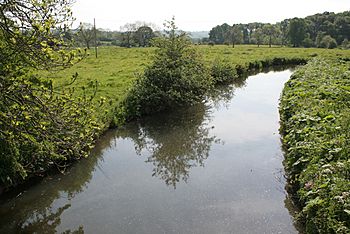River Hamps facts for kids
Quick facts for kids Hamps |
|
|---|---|

The Hamps near Winkhill
|
|
| Physical characteristics | |
| Main source | South side of Merryton Low, east of Upper Hulme |
| River mouth | Confluence with the Manifold 53°08′07″N 1°57′08″W / 53.13535°N 1.95213°W |
| Basin features | |
| Progression | Manifold—Dove—Trent—Humber—North Sea |
The River Hamps is a river located in Staffordshire, England. It is a smaller river that flows into the River Manifold. The Manifold then joins the River Dove near a village called Ilam. A large part of the River Hamps flows through the beautiful Peak District National Park.
Contents
What's in a Name?
The name Hamps comes from an old Middle English word, "Hanespe". This word itself came from an even older British name. It means "summer dry". This is a perfect name because the river often disappears underground during the warmer summer months!
Where the River Flows
The River Hamps starts high up on the moorland. Its source is on the south side of Merryton Low, which is east of Upper Hulme.
From its start, the river flows south. It passes through the villages of Onecote and Winkhill. Then, it turns east towards Waterhouses. Finally, it flows north to meet the River Manifold near a place called Beeston Tor. The woods along this last part of the river are looked after by the National Trust. They are part of the South Peak Estate.
The Manifold Way
From Waterhouses to the River Manifold, the valley has a special path. This path used to be a railway line called the Leek and Manifold Valley Light Railway. Now, it's called the Manifold Way. It's an 8-mile long path perfect for walking and cycling.
The Disappearing River
During summer, the River Hamps often vanishes! The water goes underground and comes out again at Hamps Spring, near Ilam. This means that the river bed, from north of Waterhouses all the way to where it meets the River Manifold, becomes completely dry.
A Look Back: Reservoir Plans
In the 1960s and 1970s, there were plans to build a large new reservoir. This reservoir would have been just north of Winkhill, inside the National Park. It would have been wide but not very deep. However, these plans were eventually stopped. Instead, a different reservoir was built at Carsington Water.

